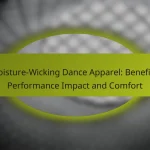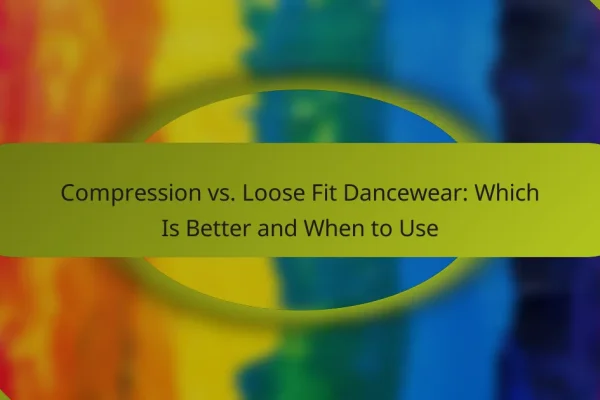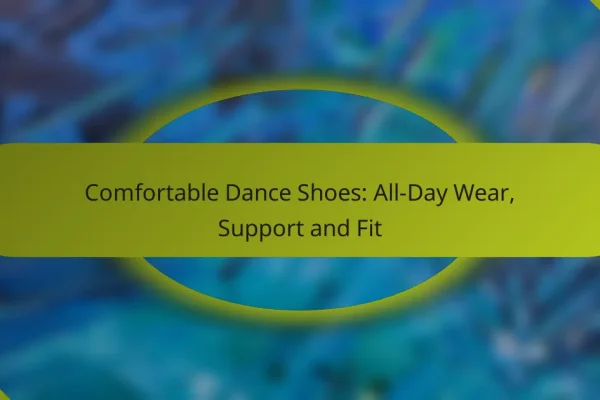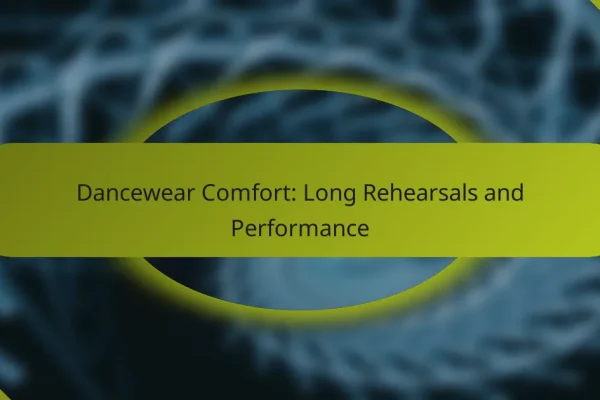How to choose the right dancewear for fit and comfort?
Choosing the right dancewear for fit and comfort involves understanding your body type, the type of movement you’ll be doing, and the materials used in the clothing. Prioritizing these factors ensures that you can perform effectively while feeling comfortable throughout your dance sessions.
Consider body type and movement
Your body type significantly influences the fit of dancewear. Different styles may suit various body shapes, so consider what feels best for your unique physique. For instance, dancers with a curvier figure might prefer styles that offer more support and coverage, while those with a leaner build may opt for more form-fitting options.
Movement is another crucial factor. If you engage in styles that require a lot of flexibility, such as ballet or contemporary dance, look for dancewear that allows for a full range of motion. Loose-fitting garments may be suitable for some styles, but they can hinder performance in others.
Evaluate fabric types and stretch
The fabric of your dancewear plays a vital role in both comfort and performance. Look for materials that provide breathability and moisture-wicking properties to keep you dry during practice. Common fabrics include cotton blends, spandex, and nylon, each offering different levels of stretch and support.
Stretch is particularly important. Fabrics with a good amount of elasticity will allow you to move freely without feeling restricted. Always check the fabric composition to ensure it meets your needs for both comfort and durability.
Check sizing charts from brands like Bloch
Before purchasing dancewear, consult the sizing charts provided by brands like Bloch to ensure a proper fit. Sizing can vary significantly between different manufacturers, so relying on standard sizes may lead to discomfort or poor fit.
Take your measurements accurately, focusing on key areas such as bust, waist, and hips. Compare these measurements against the brand’s chart to find the best size. If you are between sizes, consider the type of fit you prefer—tighter for support or looser for comfort—and choose accordingly.
What are the best brands for comfortable dancewear?
Some of the best brands for comfortable dancewear include Wear Moi, Capezio, and Danskin. These brands are known for their quality materials, thoughtful designs, and a focus on fit, making them popular choices among dancers.
Wear Moi for ballet
Wear Moi specializes in ballet attire, offering a range of leotards, tights, and skirts that prioritize comfort and style. Their products often feature breathable fabrics and elegant designs, catering to both professional dancers and beginners.
When selecting Wear Moi items, consider the fit and flexibility of the materials. Many dancers appreciate the brand’s attention to detail, such as adjustable straps and flattering cuts, which enhance movement and comfort during practice or performances.
Capezio for versatility
Capezio is renowned for its versatile dancewear suitable for various styles, including ballet, jazz, and contemporary dance. Their wide selection includes leotards, leggings, and shoes, making it easy to find the right outfit for different dance forms.
Look for Capezio’s signature features like moisture-wicking fabrics and reinforced seams, which provide durability and comfort. Their products often come in a variety of colors and sizes, allowing dancers to express their personal style while ensuring a good fit.
Danskin for affordability
Danskin offers affordable dancewear without compromising on quality, making it a great choice for budget-conscious dancers. Their range includes basic leotards, tights, and activewear that are functional and comfortable.
When shopping for Danskin items, consider their sizing options and fabric choices. Many dancers find that Danskin’s products provide good value, especially for beginners or those participating in recreational dance classes.
How does fit affect performance in dancewear?
The fit of dancewear significantly impacts a dancer’s performance by enabling freedom of movement and ensuring comfort. Properly fitting garments can enhance agility and reduce distractions, allowing dancers to focus on their technique and expression.
Improves range of motion
A well-fitted dancewear allows for optimal range of motion, which is crucial for executing various dance movements. When clothing is too tight or too loose, it can restrict movement, leading to compromised performance and potential injury.
To ensure maximum flexibility, look for materials that offer stretch, such as spandex or lycra, and consider styles that are designed specifically for your dance discipline. For example, fitted leggings or bodysuits can provide support while allowing for dynamic movements.
Enhances confidence and posture
Wearing dancewear that fits well can boost a dancer’s confidence and improve their posture. When dancers feel comfortable and secure in their attire, they are more likely to perform with poise and expressiveness.
Choose dancewear that flatters your body shape and provides adequate support. For instance, a supportive sports bra can enhance posture by keeping the shoulders back, while high-waisted leggings can create a streamlined silhouette. This combination not only looks good but also helps dancers maintain proper alignment during performances.
What features should I look for in dancewear?
When selecting dancewear, prioritize features that enhance fit and comfort, such as moisture-wicking properties, seamless construction, and adjustable straps. These elements play a crucial role in ensuring that your dance attire supports your movements and keeps you comfortable during practice and performances.
Moisture-wicking properties
Moisture-wicking fabrics are essential in dancewear as they draw sweat away from the body, keeping you dry and comfortable. Look for materials like polyester or nylon blends that are specifically designed to manage moisture effectively. This feature is particularly important during intense dance sessions where perspiration levels can be high.
When shopping, check for labels that indicate moisture-wicking capabilities. Fabrics that dry quickly can significantly enhance your comfort and performance, allowing you to focus on your movements rather than feeling damp or heavy.
Seamless construction for comfort
Seamless construction in dancewear minimizes friction and irritation, which is vital for unrestricted movement. Garments designed without seams or with flatlock seams provide a smoother fit, reducing the risk of chafing during extended wear. This is especially beneficial for dancers who practice for long hours.
Consider trying on seamless options to see how they feel during movement. A well-constructed piece will allow you to perform without distractions, making it easier to concentrate on your technique and expression.
Adjustable straps for support
Adjustable straps in dancewear offer customizable support, which is crucial for achieving the right fit. This feature allows you to modify the tightness and positioning of the straps, ensuring that your attire stays in place while you dance. Look for styles with sliders or hooks that make adjustments easy.
When selecting dancewear, consider how the straps interact with your body type and movement style. Properly adjusted straps can enhance comfort and support, preventing any wardrobe malfunctions during performances or rehearsals.
How to care for dancewear to maintain fit?
To maintain the fit of dancewear, proper care is essential. This includes following washing instructions, avoiding certain fabric treatments, and storing garments correctly to prevent stretching.
Follow washing instructions carefully
Each piece of dancewear typically comes with specific washing instructions that are crucial for preserving its fit and elasticity. Always check the care label for recommended water temperatures and washing cycles.
For most dancewear, a gentle cycle with cold water is advisable to prevent shrinkage and fabric damage. Washing by hand can be an even safer option for delicate materials.
Avoid fabric softeners
Fabric softeners can leave a residue that affects the stretch and breathability of dancewear. Instead of using softeners, consider adding a cup of white vinegar to the rinse cycle to help maintain fabric softness without compromising performance.
Choosing detergent specifically designed for activewear can also help keep dancewear in optimal condition while avoiding harsh chemicals that may degrade the fabric.
Store properly to avoid stretching
Proper storage of dancewear is vital to prevent stretching and deformation. Hang items on padded hangers or fold them neatly to avoid creases and stress on the fabric.
Avoid cramming dancewear into tight spaces, as this can lead to unwanted stretching. Instead, store them in a cool, dry place away from direct sunlight to maintain their shape and elasticity.
What are the common sizing issues in dancewear?
Common sizing issues in dancewear often stem from inconsistent sizing across different brands and variations in body measurements. These discrepancies can lead to discomfort and hinder performance, making it crucial for dancers to understand how to navigate these challenges.
Inconsistent sizing across brands
Sizing standards can vary significantly between dancewear brands, leading to confusion when selecting the right size. For instance, a size medium in one brand may fit like a small in another, making it essential to consult each brand’s specific sizing chart before purchasing.
To mitigate this issue, dancers should try on garments whenever possible or order multiple sizes to determine the best fit. Reading customer reviews can also provide insight into how a particular brand’s sizing runs, helping to make more informed decisions.
Variations in body measurements
Individual body measurements can differ widely, affecting how dancewear fits. Dancers may have unique proportions, such as longer torsos or shorter legs, which standard sizes may not accommodate. This can lead to garments that are either too tight or too loose in certain areas.
To address this, dancers should take accurate measurements of their bust, waist, hips, and inseam. Comparing these measurements against sizing charts can help find a more tailored fit. Custom or made-to-measure options are also available for those who struggle to find suitable sizes in off-the-rack dancewear.
How do I find the right dancewear for different styles?
Finding the right dancewear for various styles involves understanding the specific requirements of each dance form and selecting garments that enhance performance and comfort. Consider factors like fabric, fit, and functionality to ensure you choose the best attire for your needs.
Ballet
For ballet, look for leotards, tights, and skirts that allow for a full range of motion. Fabrics should be stretchy and breathable, such as cotton or spandex blends. Ensure the fit is snug but not restrictive, allowing for graceful movements.
Common choices include long-sleeve leotards for cooler environments or short-sleeve options for warmer studios. Don’t forget ballet shoes, which should fit snugly and provide support without being too tight.
Jazz
Jazz dancewear typically includes fitted tops, pants, and shorts that allow for dynamic movement. Look for materials that wick moisture away, such as polyester or nylon blends, to keep you comfortable during high-energy routines.
Consider jazz shoes that offer flexibility and support. When selecting outfits, prioritize items that allow for easy transitions between movements, such as cropped tops paired with high-waisted pants.
Hip Hop
Hip hop dancewear is often more relaxed and baggy, focusing on comfort and style. Choose oversized tees, joggers, or shorts made from breathable fabrics to facilitate movement and expression.
Footwear is crucial; opt for sneakers that provide good grip and cushioning. Avoid overly tight clothing, as it can restrict movement and hinder performance.
Contemporary
Contemporary dancewear combines elements from various styles, often featuring flowing fabrics and layered looks. Look for tops and bottoms that allow for fluid movement, such as tank tops paired with leggings or skirts.
Materials like chiffon or jersey are popular for their drape and comfort. Ensure that your outfit allows for both expressive movements and stability during transitions.
Tap
For tap dancing, select fitted clothing that won’t get in the way of your footwork. Tap shoes are essential, so ensure they fit well and provide the right sound and support.
Consider wearing fitted tops with either leggings or shorts to showcase your footwork. Avoid overly loose clothing, as it can obscure your movements and make it harder to hear the taps.










